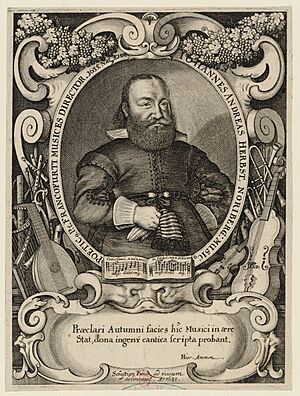Johann Andreas Herbst facts for kids
Johann Andreas Herbst (born June 9, 1588 – died January 24, 1666) was a German composer and music theorist. He lived during the early Baroque period. He was a contemporary of famous composers like Michael Praetorius and Heinrich Schütz. Like them, Herbst helped bring the grand Venetian music style to Protestant Germany.
Contents
Life of Johann Andreas Herbst
Johann Andreas Herbst was born in Nuremberg, Germany. He probably received his early education there. He might have studied with Hans Leo Hassler, a leading German composer of that time. Hassler taught in Nuremberg when Herbst was a student. Their music styles were quite similar.
Herbst became a Kapellmeister (a music director) in 1614 at Butzbach. He then moved to Darmstadt in 1618. In 1623, he became Kapellmeister in Frankfurt am Main.
In 1636, he returned to Nuremberg, his hometown. However, this job was not easy for him. He wrote about his time there with sadness. So, in 1644, he went back to Frankfurt. He stayed there for the rest of his life. His most creative period was during his time in Nuremberg and his second stay in Frankfurt. During these years, he wrote his important music books and most of his church music.
Johann Andreas Herbst's Writings
Herbst was one of the most important German music theorists in the early 1600s. Only Michael Praetorius was more famous for his music theories. Herbst wrote two very important books: Musica practica and Musica poetica. These books were written in German, not Latin, which made them very helpful for musicians.
Musica practica was a guide on how to sing well. It taught musicians how to add beautiful decorations to their music. Musica poetica was a guide on how to compose music. It included exercises on counterpoint (combining different melodies). It also taught how to set words carefully to music. Some parts of Musica practica were inspired by Michael Praetorius's earlier book, Syntagma musicum.
Later in his life, Herbst translated several Latin music writings into German. He published them together under the title Arte prattica & poetica.
Musical Style and Influence
Herbst wrote many different types of music. These included cantatas, chorales, chorale concertos, motets, and psalm settings. Most of his works were religious. He did not write any music just for instruments.
Some of his music used the grand Venetian polychoral style. This style used many different groups of singers and instruments. He used this style especially before the Thirty Years' War. During the war, it became hard to find many musicians. So, composers like Herbst started writing music that needed fewer performers.
Herbst's books of motets and his Teatrum amoris (which was like the Italian madrigal) did not use the continuo style. This style was very popular in Italy at the time. However, Herbst did use many other new Baroque techniques. These techniques were brought to Germany by composers like Hassler and Schütz. The concertato style, which mixed instruments and voices, was well-developed in Herbst's early music. But the monodic style, popular in Italy and used by Schütz, was not found in Herbst's music.
One of his last and simplest music collections was published in 1659. It contained 29 chorales written for five voices.
See also
 In Spanish: Johann Andreas Herbst para niños
In Spanish: Johann Andreas Herbst para niños


